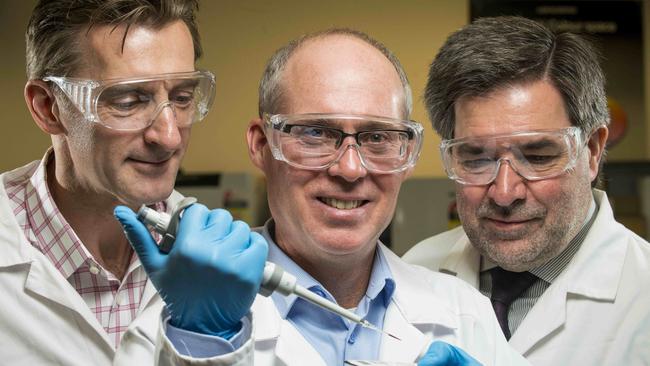Lifesaving gadget could revolutionise trauma treatment
Every year about two million people are at risk of bleeding to death in instances of major trauma, but researchers have now come up with an ingenious gadget for paramedics.

Victoria
Don't miss out on the headlines from Victoria. Followed categories will be added to My News.
A world-first portable gadget could help save patients from bleeding to death in instances of major trauma, including serious car crashes or shark attacks.
Monash University engineers have designed a diagnostic testing device that measures the concentration of a blood-clotting protein in the body.
The protein, called fibrinogen, is needed to clot the blood and prevent major haemorrhaging and fatal blood loss.
In accidents or events of significant body trauma fibrinogen levels can quickly drop.
This puts the patient at risk of complications and death, and requires an immediate boost of the protein to be administered.
Currently, the only way to test a patient’s fibrinogen levels is in hospital using a large machine, which takes about 20 minutes.
But researchers hope the Monash device could be used at the emergency site to quickly alert first responders when a fibrinogen injection is needed and buy them enough time to stabilise the patient.
“We want to allow the paramedic to be able to provide the emergency fibrinogen where it is needed, within the first half an hour,” Professor Gil Garnier, who worked on the design, said. “That’s when it matters.

“This test is a gift of time — more time for the doctor, the paramedic, to treat the problem.”
The handheld device is made simply from a glass slide, Teflon film and a piece of paper and can test the protein levels in just four minutes.
It combines a swab of the patient’s blood and an enzyme solution on to the glass, separating out the blood plasma and allowing it to clot before a strip of paper is placed on top.
The further the blood moves down the strip, the lower the fibrinogen concentration they have.
Prof Garnier said about two million people were at risk of dying from low fibrinogen levels in trauma circumstances every year across the globe.
“Time is life,” Prof Garnier said. “We’ve showed it’s possible (to test) and now our dream is to develop something robust and commercialised for every ambulance in Australia, and then the world, to have this test.”
Clare Manderson, a chemical engineering Research Fellow and co-author of the study, said the design was a “game changer”.
“Our capacity to develop this diagnostic using cheap and readily available materials means it can be easily commercialised for use across the world,” she said.
“It will also ease pressure on emergency departments knowing that this lifesaving treatment can be delivered on site and in quick time.
The testing device was developed through a collaboration between Monash’s Department of Chemical Engineering and BioPRIA (Bioresource Processing Institute of Australia) and Melbourne-based company Haemokinesis and published this week in journal, ACS Sensors.
RELATED:
BIGGEST MEDICAL BREAKTHROUGHS MADE IN VICTORIA IN PAST 30 YEARS
GENE DISCOVERY MAY HELP DETECT AGGRESSIVE PROSTATE CANCER

